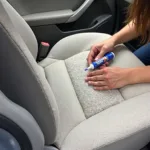Leather car seats add a touch of luxury and sophistication to any vehicle. However, they are also susceptible to stains from spills, dirt, and everyday wear and tear. If you’re facing unsightly blemishes on your prized leather upholstery, don’t fret! This guide provides you with expert advice on how to repair stained leather car seats and restore them to their former glory.
Identifying the Stain Type
Before you begin the stain removal process, it’s crucial to identify the culprit behind the blemish. Different stains require different approaches for effective treatment. Here’s a breakdown of common car seat stains and their characteristics:
- Water Stains: Appear as light or dark rings on the leather surface. They are often caused by condensation from drinks or rainwater.
- Grease Stains: Dark, oily marks typically left by food, lotions, or cosmetics. They tend to penetrate the leather’s pores.
- Ink Stains: Usually from pens or markers, these stains can be stubborn and require specific cleaning agents.
- Dye Transfer Stains: Caused by color transfer from clothing, denim being a common offender. The dye seeps into the leather’s pores.
Effective Cleaning Solutions for Leather Car Seats
Once you’ve identified the stain type, it’s time to choose the right cleaning solution. Fortunately, you don’t need harsh chemicals to get the job done. Here are some effective and safe options:
1. Saddle Soap for General Cleaning:
Saddle soap, specifically designed for leather care, is excellent for general cleaning and removing mild stains. Its gentle formula lifts dirt and grime without stripping the leather’s natural oils.
2. Vinegar Solution for Water Stains:
A mixture of equal parts white vinegar and distilled water can effectively tackle water stains on leather car seats. The vinegar’s mild acidity helps to break down mineral deposits.
3. Baking Soda Paste for Grease Stains:
Baking soda’s absorbent properties make it a powerful tool against grease stains. Create a paste by mixing baking soda with a small amount of water and apply it to the affected area. Let it sit for a few minutes before gently wiping it away.
4. Rubbing Alcohol for Ink Stains (with Caution):
Isopropyl alcohol, commonly known as rubbing alcohol, can be effective on ink stains. However, it’s crucial to test it on an inconspicuous area first, as it can potentially discolor some types of leather.
Step-by-Step Guide to Removing Stains
Follow these steps for optimal stain removal on your leather car seats:
- Preparation: Gather your cleaning supplies, including a soft-bristled brush, microfiber cloths, and the appropriate cleaning solution.
- Vacuuming: Thoroughly vacuum the seats to remove loose dirt and debris that can scratch the leather during cleaning.
- Spot Test: Before applying any cleaning solution to the entire stain, test it on a hidden area to ensure it doesn’t damage or discolor the leather.
- Gentle Cleaning: Apply the chosen cleaning solution to a microfiber cloth and gently rub the stain using circular motions. Avoid using excessive force, as this can push the stain further into the leather.
- Rinsing: For most solutions, use a damp cloth to rinse away any residue. Leather is porous and can absorb cleaning agents, so proper rinsing is crucial.
- Drying: Use a clean, dry microfiber cloth to dry the area thoroughly. Avoid using heat or direct sunlight for drying, as this can damage the leather.
Preventing Future Stains
Protecting your leather car seats from future stains is always easier than removing them. Here are some preventive measures:
- Regular Cleaning: Establish a routine of cleaning your leather seats every few weeks to prevent dirt and grime from building up.
- Leather Conditioner: Use a high-quality leather conditioner to keep the leather moisturized and supple. This helps to prevent cracking and staining.
- Seat Covers: Consider using seat covers, especially if you frequently transport children or pets. Seat covers provide an extra layer of protection against spills and dirt.
Seeking Professional Help
While DIY methods can be effective for many stains, some situations may require professional attention. If you’re dealing with:
- Severe Stains: Deeply ingrained stains that don’t respond to home remedies.
- Tears or Rips: Professional repair is necessary to address structural damage.
- Valuable Leather: For high-end or classic cars, it’s best to entrust the care of valuable leather to experts.
If you are unsure about how much to repair a small tear in a car seat or how to repair a small tear in a cloth car seat, it’s best to consult with a professional for an accurate assessment and repair options. Professional detailers and upholstery specialists have the expertise and specialized tools to handle challenging stain removal and repairs.
“When it comes to valuable leather interiors, I always advise car owners to err on the side of caution. Attempting DIY repairs on delicate leather can sometimes do more harm than good,” says John Miller, a seasoned auto detailer with over 20 years of experience. “Professional detailers have the knowledge and specialized tools to safely and effectively tackle even the toughest stains.”
Conclusion
Maintaining the pristine appearance of your leather car seats requires proactive care and attention. By understanding the nature of different stains and utilizing the right cleaning techniques, you can keep your leather upholstery looking its best for years to come. Remember, regular cleaning, conditioning, and seeking professional help when needed are key to preserving the beauty and value of your vehicle’s interior.



